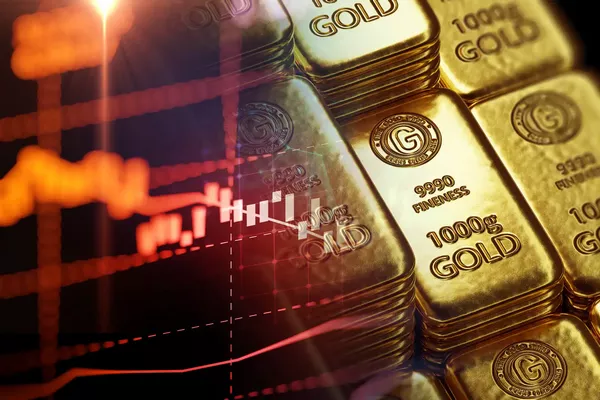What Happens to Gold Prices in a Recession?
In times of economic uncertainty, investors often turn to gold as a safe-haven asset. The precious metal has long been regarded as a store of value and a hedge against inflation. However, when a recession hits, the dynamics of the gold market can change. In this article, we will explore what typically happens to gold prices during a recession and the factors that influence its performance.
1. The Initial Rise: Flight to Safety
One of the initial reactions to a recession is a flight to safety, where investors seek refuge in assets that are considered less risky. Gold is often seen as a safe-haven asset during times of economic turmoil. Consequently, its demand tends to rise, causing an initial increase in gold prices. Investors view gold as a reliable store of value that can protect their wealth during uncertain times.
2. Central Bank Policies
During a recession, central banks often implement expansionary monetary policies to stimulate the economy. These policies usually involve lowering interest rates and injecting liquidity into the financial system. Such actions can have an impact on gold prices. When interest rates are low, the opportunity cost of holding gold diminishes, making it more attractive for investors. Additionally, the increased liquidity in the system can lead to concerns about inflation, further driving up demand for gold as an inflation hedge.
3. Investor Sentiment and Market Volatility
Investor sentiment plays a crucial role in determining gold prices during a recession. As fear and uncertainty grip financial markets, investors tend to seek safe-haven assets. Gold, with its long-standing reputation, becomes an appealing option. The increased demand for gold can push its prices higher. Moreover, market volatility tends to rise during economic downturns, which can amplify the demand for gold as investors look for stability in their portfolios.
4. Currency Movements
Gold is priced in US dollars, and as a result, currency movements can impact its prices. During a recession, central banks may engage in currency devaluation or engage in quantitative easing measures, which can weaken their respective currencies. When the value of a currency declines, it takes more of that currency to purchase an ounce of gold. This can lead to an increase in gold prices in those currencies, as investors seek to protect their wealth from currency depreciation.
5. Industrial Demand
Gold has various industrial applications, including electronics, jewelry, and dentistry. During a recession, the demand for gold in these industries may decline due to reduced consumer spending and business activity. This decrease in industrial demand can put downward pressure on gold prices. However, the impact of industrial demand on gold prices is generally smaller compared to other factors such as investment demand and macroeconomic conditions.
6. Government Policy Response
Government policies implemented during a recession can also affect gold prices. Measures such as fiscal stimulus packages, quantitative easing, or changes in regulations can impact market sentiment and investor behavior. If government actions are perceived as inflationary or detrimental to the stability of the financial system, it can drive up demand for gold as a safe-haven asset and subsequently push its prices higher.
7. Recovery and Beyond
As an economy moves towards recovery after a recession, the dynamics of the gold market may undergo further changes. If the recovery is strong and investor confidence returns, there may be a decrease in demand for gold as a safe-haven asset, which could lead to a decline in its prices. However, if the recovery is sluggish or accompanied by concerns about inflation or financial stability, gold prices may continue to be supported.
Conclusion
While it is challenging to predict the precise trajectory of gold prices during a recession, several key factors can influence its performance. The initial flight to safety, central bank policies, investor sentiment, currency movements, industrial demand, and government policy responses all contribute to the fluctuation of gold prices during economic downturns. These factors interact in a complex manner, and their combined effect determines the overall movement of gold prices.
It is important to note that historical trends may provide some insights into how gold prices have behaved during previous recessions. For instance, during the global financial crisis in 2008, gold experienced a significant increase in value as investors sought shelter from the turmoil in the financial markets. Similarly, during the COVID-19 pandemic in 2020, gold prices reached record highs due to the uncertainty surrounding the global economy.
However, past performance does not guarantee future results. Each recession is unique, influenced by various factors such as the severity of the downturn, government policies, and global economic conditions. Therefore, it is crucial to consider these factors and their potential impacts on gold prices in any analysis or decision-making process.
Investors should also be aware that while gold can serve as a safe-haven asset, it is not without risks. Like any investment, gold prices can be subject to volatility, and there is no guarantee of a positive return. It is important to diversify one’s investment portfolio and consider other factors such as personal financial goals, risk tolerance, and time horizon when making investment decisions.
In conclusion, gold prices during a recession are influenced by a variety of factors, including flight to safety, central bank policies, investor sentiment, currency movements, industrial demand, and government policy responses. These factors interact and evolve throughout the course of a recession, shaping the trajectory of gold prices. While gold is often perceived as a safe-haven asset, investors should carefully evaluate their investment strategies and consider a holistic approach to managing their portfolios.


